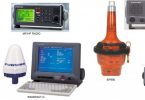-
Super high holding power (SHHP) anchors
(a) Definition
A super high holding power anchor is an anchor with a holding power of at least four times that of an ordinary stockless anchor of the same mass. A super high holding power anchor is suitable for restricted service vessels’ use and does not require prior adjustment or special placement on the sea bed.
(b) Limitations to Usage
The use of SHHP anchors is limited to restricted service vessels as defined by the individual classification society. The SHHP anchor mass should generally not exceed 1500kg.
(c) Application
The unified requirement for the design of SHHP anchors applies down to EN ≥ 205.
For EN < 205
The design criteria for SHHP anchors apply to the anchor mass given in Recommendation 10 for ordinary stockless anchors, reduced as permitted in accordance with 1.1 (b) of Recommendation 10.
(d) Anchor Design
i) Anchor Use
A super high holding power anchor is to be suitable for vessels in restricted service and is not to require prior adjustment or special placement on the sea bed.
ii)Anchor Mass
When super high holding power anchors of the proven holding power given in e) below are used as bower anchors, the mass of each such anchor may be reduced to not less than 50% of the mass required for ordinary stockless anchors in Table 1.
(e) Anchor Holding Power
For approval and/or acceptance as a SHHP anchor satisfactory full scale tests are to be made confirming that the anchor has a holding power of at least four times that of an ordinary stockless anchor or at least two times that of a previously approved HHP anchor, of the same mass.
The tests are also to verify that the anchor withstands the test without permanent deformation.
(f) Anchor Holding Power Tests
i) The full scale tests required by e) are to be carried out at sea on three types of bottom; normally, soft mud or silt, sand or gravel and hard clay or similar compounded material. The tests are to be applied to anchors of mass which are as far as possible representative of the full range of sizes proposed.
For a definite group within the range, the two anchors selected for testing (ordinary stockless and SHHP anchors) should be approximately the same mass and should be tested in association with the size of chain required for the anchor mass and anchor type. Where an ordinary stockless anchor is not available, a previously approved HHP anchor may be used in its place.
The length of the cable with each anchor should be such that the pull on the shank remains practically horizontal. For this purpose a scope of 10 is considered normal.
Three tests shall be taken for each anchor and each type of bottom. The pull shall be measured by dynamometer.
The stability of the anchor and ease of breaking out should be noted where possible. Tests are to be carried out from a tug but alternativaly shore based tests may be accepted. Measurements of pull, based on the RPM/bollard pull curve of the tug may be accepted as an alternative to dynanometer.
Tests in comparison with a previously approved SHHP anchor may be also accepted as a basis for approval. If approval is sought for a range of anchor sizes, then at least three anchor sizes are to be tested, indicative of the bottom, middle and top of the mass range.
ii)The holding power test load is not to exceed the proof load of the anchor.


